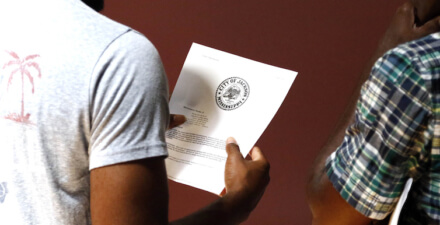The logistics of a reparations program in the United States

This essay is part of Vision 2020: Evidence for a stronger economy, a compilation of 21 essays presenting innovative, evidence-based, and concrete ideas to shape the 2020 policy debate. The authors in the new book include preeminent economists, political scientists, and sociologists who use cutting-edge research methods to answer some of the thorniest economic questions facing policymakers today.
To read more about the Vision 2020 book and download the full collection of essays, click here.
Overview
The idea of reparations for African Americans is receiving renewed attention, driven in part by the willingness of an unprecedented number of prominent policymakers and presidential candidates to entertain the idea of opening a serious discussion on the topic. Past and current research demonstrates the deep, abiding suffering and harm inflicted on African Americans due to the practice and legacy of slavery and post-Civil War laws and regulations that prevented so many of the enslaved and most of their descendants from reaping all but meager benefits from the sustained growth of the U.S. economy since colonial times.
My essay presents a brief history of the various reparations movements in the United States following the end of the Civil War and the Reconstruction era in the South through to today, a discussion of the logistics of carrying out a reparations program, and research-based recommendations for policymakers. Investigating the size of reparations and how they would be disbursed will first require a commission to be set up to decide appropriate levels of reparations, and policymakers will then need to implement the best financial vehicles for disbursement of the funds. I also recommend ways for policymakers to ensure that ongoing racial discrimination can be accounted for and resolved.
A brief history
Near the close of the Civil War, on January 16, 1865, General William T. Sherman signed Special Field Orders No. 15, which temporarily allotted each formerly enslaved family living along the Atlantic coasts of South Carolina, Georgia, and Florida no more than 40 acres of land on which to settle and make a living. President Andrew Johnson later reversed these orders and returned the land to white southerners.1 Many descendants of formerly enslaved persons point to these “40 acres and a mule” as an unfulfilled promise by the U.S. government and a basis for the earliest calls for reparations for slavery.
Since that time, there have been multiple judicial, legislative, and grassroots efforts advocating for reparations for African Americans for their enslavement and the discriminatory consequences reaped by their descendants. In the judicial arena, there have been multiple lawsuits filed in the United States and the United Kingdom against financiers, insurers, and shipping companies that profited from slavery. In 2002, lawyer and human rights activist Deadria Farmer-Peallmann coordinated lawsuits against the U.S. insurer Aetna Inc., then-independent (and now Bank of America Corp.-owned) FleetBoston Financial, and other corporations for their role in the slave trade of the 17th and 18th centuries. The cases were ultimately dismissed for lack of standing, exceeding the statute of limitations, and for being deemed a political matter outside the scope of the judiciary.2
Legislatively, Rep. John Conyers (D-MI) introduced H.R. 40—a bill to establish a Commission to Study Reparation Proposals for African Americans—in every Congress from 1989 until his resignation in 2017. The bill never made it out of committee. In 2019, Rep. Sheila Jackson Lee (D-TX) reintroduced the bill, and prominent 2020 Democratic presidential candidates have endorsed it.3 Increased support for the current bill may be due, in part, to an increase in recent support for reparations on online social media platforms such as Facebook and Twitter.
Importantly, these grassroots efforts promoting reparations for African Americans build upon earlier waves of activism. At the turn of the 20th century, Callie House, a poor washerwoman who was born into slavery, lobbied Congress to provide old age pensions for the formerly enslaved who were no longer physically able to work to support themselves.4 Her efforts were stymied by the full force of the U.S. government. More recently, organizations such as the Universal Association of Ethiopian Women founded by Queen Mother Moore in the 1950s5 and the National Coalition of Blacks for Reparations in America, founded in the late 1980s,6 have advocated for reparations for decades. These organizations kept alive the idea of the efficacy of reparations.
Much more recently, author and columnist Ta-Nehisi Coates’ influential article “The Case for Reparations,” published in The Atlantic in 2014, revived popular interest in reparations. His widely read analysis helped broaden the discussion of the basis for reparations to include the Jim Crow era of state-sanctioned discrimination in the wake of the Civil War up until the Civil Rights era of the 1960s, the discriminatory federal, state, and local laws, policies, and ordinances prevalent during the New Deal and post-World War II eras, and ongoing institutional racism in employment, education, and the criminal justice system.7
The logistics of carrying out a reparations program
By definition, reparations involve the making of amends to those who have been wronged, whether through money or by other means. Key logistical questions that arise when conceptualizing reparations for African Americans include:
- Who should be eligible to receive reparations?
- How much money should be allocated to fund a reparations program, and how should it be financed?
- What form should reparations take? Should there be a cash payment, investment in social programs, trust funds for education, homeownership or business investing, or some combination of these ideas?
I answer each of these questions in turn.
Who should be eligible?
As previously mentioned, prior attempts to sue for reparations were rejected in part due to a lack of standing—a legal term indicating whether the people suing for damages can demonstrate that they are the people who have actually suffered damages. Although a reparations plan developed in the legislative branch would not initially be subject to the judicial concept of standing, the plan could be challenged in the courts on the grounds of constitutionality, and standing may be one dimension that could be legally scrutinized. In order to withstand that scrutiny, a reparations plan should accrue to those who have been wronged and/or their descendants. Eligibility then would depend on the reason for redress.
Reparations for slavery should accrue to the descendants of those who were formerly enslaved in the United States. Descendants of enslaved persons from other nations, such as Jamaica, Haiti, and Brazil who are currently living in the United States should not be eligible and should instead seek reparations against the nations primarily responsible for enslavement in those nations and regions. U.S. policymakers will have to determine whether current U.S. citizenship is a requirement for receiving reparations.8
Reparations for state-sanctioned discrimination during the Jim Crow, New Deal, and post-WWII eras should accrue to any African Americans who were living in the United States during those time periods or their descendants, regardless of whether their ancestors were enslaved in the United States. Black immigrants from the West Indies and Africa also faced state-sanctioned discrimination in this country during this period even if they were voluntary immigrants to the United States.9
How much?
Research teams are currently working on refining reparations estimates, but estimates that have been calculated in the past (mostly in the 1990s and early 2000s) range from $500 billion to $6 trillion.10 Dividing this amount evenly among the roughly 40 million people identified as black or African American in the 2010 Census yield estimates of $12,500 to $150,000 per person. The wide range arises from differences both in calculation methods and in the underlying rationale for reparations (slavery, Jim Crow, or ongoing discrimination).
Prominent reparations researcher and Equitable Growth Research Advisory Board member William A. Darity, Jr. at Duke University took the value of 40 acres of land in 1865 (the aforementioned unfulfilled promise made to formerly enslaved families at the end of the Civil War), multiplied that value by 4 million formerly enslaved persons, and calculated the present value compounded yearly at 6 percent interest to arrive at $1.3 trillion in 2008 dollars.11 University of Illinois Urbana-Champaign economist Larry Neal calculated the difference between the wage that an enslaved person would have received if paid for work and the amount spent by enslavers on food and shelter for the enslaved from 1620 to 1840 and compounded that value yearly at 5 percent to arrive at $4 trillion.12
Estimates that include discrimination during the Jim Crow, New Deal, and post-WWII eras are necessarily larger. Using U.S. Census of Agriculture data on black ownership of agricultural land from 1910 to 1997, a group of researchers estimated losses to the countless black farmers who fell victim to violent dispossession of their land prior to the Civil Rights reforms of the 1960s, as well as those who lost land due to discriminatory federal farm credit policies and the discriminatory implementation of federal, state, and local agricultural policies, before, during, and after the Civil Rights era. By their most conservative estimate, the dispossession of black agricultural land resulted in the loss of hundreds of billions of dollars of black wealth.13
To adjudicate the amount of reparations based on a timeline of amends that need to be redressed, a commission impaneled by Congress to study the question of reparations should be tasked with evaluating the strengths and weaknesses of all available estimates and calculation methods to arrive at separate values for reparations for slavery, reparations for the era of state sanctioned discrimination, and reparations for ongoing institutional discrimination.
What form?
A reparations program can take many forms, including:
- Cash payments
- Investment in social programs
- Trust funds
- An official apology
- Institutional reform
- Public education about slavery and racial discrimination
Rep. James Clyburn (D-SC), a Civil Rights-era veteran, argues against reparations taking the form of cash payments on the grounds that it would be logistically difficult to carry out. Instead, he and many other policymakers support investing in impoverished communities as a form of reparations.14 Critics of reparations programs that focus on broad-based social programs, however, argue that they cannot be considered reparations if they do not specifically and solely target African Americans.
Some people in our society may be opposed to cash reparations payments under the misguided assumption that African Americans cannot be trusted to spend cash payments in ways that will benefit them economically.15 While this assumption is unsubstantiated and potentially rooted in racial bias and paternalism, researchers have demonstrated that policymakers should be cautious about cash payments for another reason—it is possible that cash reparations payments could further impoverish black Americans relative to nonblack Americans if there are no available vehicles for African Americans to invest that money back into black communities.16
Given that black Americans own less than 10 percent of all small businesses in the United States17 and hold less than 15 percent of their wealth in business investments,18 cash reparations payments in the current environment could possibly find their way back into the pockets of nonblack Americans, both through consumption spending and through investments held in mainstream financial institutions, potentially further widening the racial wealth divide.
This possible drawback, however, does not have to be an argument against cash reparations payments, but rather an acknowledgement that any cash reparations payments should be coupled with the development of an investment infrastructure that could provide opportunities for recipients to invest in black communities and black-owned businesses and to create black-owned financial institutions.
Ultimately, the form a reparations program should take depends on the underlying goals. If the goal is to address the wealth gap created by discriminatory government actions such as redlining—the practice of overt housing discrimination in the post-WWII era—and Jim Crow discriminatory laws and regulations, then cash payments or trust funds for investments in housing, education, or businesses may be the most appropriate form. If the goal is to repair or make whole those who were disadvantaged by the legacy of slavery and discrimination, then an official apology, a program of public education about slavery and discrimination, and investment in social programs targeted at reducing racial disparities may be the most effective forms. If the goal is to address ongoing discrimination against African Americans, institutional reform may be in order.
Policymakers tasked with determining the appropriate form for a reparations program should consider the underlying goals of the program to assess the most appropriate form.
Addressing ongoing discrimination
Even if policymakers do not incorporate the damages from ongoing discrimination into the calculation of reparations for African Americans, no reparations program will be complete without somehow addressing the existence of that ongoing discrimination in the U.S. economy today. As long as institutional discrimination persists, there will be continued grounds for future reparations claims.
As an example, reporters for the New Food Economy recently identified ongoing discrimination at the U.S. Department of Agriculture against black farmers that has contributed to unjust foreclosures. Among other findings, they report that under the administration of President George W. Bush, the department sat on civil rights complaints that alleged lending discrimination until the statute of limitations on those complaints ran out. Then, officials in the Obama administration did not seek extensions from Congress on the statute of limitations, instead actively foreclosing on black farmers who had pending lending discrimination complaints.19
Even if the descendants of black farmers were made whole for the loss of black agricultural land during the Jim Crow era, future generations would have claims for reparations based on the documented ongoing discrimination by the USDA. To guard against this particular instance of discrimination, Congress should enact legislation that prevents any arm of government that is accused of discrimination from failing to act on the discrimination complaints until the statute of limitations runs out.
There are certainly other instances of government agencies using loopholes to get around civil rights protections meant to guard against ongoing discrimination. Any reparations program should also establish a commission to examine structural discrimination within federal, state, and local government and propose institutional reforms that reinforce civil rights protections to guard against the need for future redress.
Download FileThe logistics of a reparations program in the United States
Conclusion
In conceptualizing a reparations program for African Americans, the roadmap for policymakers to follow is fairly straightforward. They should:
- Establish the basis for which reparations are owed—slavery, the period of state-sanctioned discrimination, and/or ongoing institutional discrimination
- Determine the goal of a reparations program—to make whole those who were wronged, to close racial wealth gaps, and/or to address ongoing discrimination
- Create a commission to estimate the value to be set aside for a reparations program
- Decide the appropriate form a reparations payment should take
- Incorporate a plan to address ongoing discrimination
In this way, centuries spent by African Americans not sharing in the full fruits of phenomenal U.S. economic growth over the course of the past 400 years can be addressed, so that they can more fully contribute to and accrue the full benefits of living in the world’s wealthiest nation in history.
—Dania V. Francis is an assistant professor of economics at the University of Massachusetts Boston.
End Notes
1. Steven F. Miller, “Order by the Commander of the Military Division of the Mississippi” (College Park, MD: Freedman and Southern Society Project, 2019), available at http://www.freedmen.umd.edu/sfo15.htm.
2. “In re African-American Slave Descendants Litigation (2004).” In Michael T. Martin and Marilyn Yaquinto, eds., Redress for Historical Injustices in the United States (Durham, NC: Duke University Press, 2007), pp. 668–72.
3. Commission to Study and Develop Reparation Proposals for African-Americans Act, H.R. 40, 116th Cong. (2019), available at https://www.congress.gov/bill/116th-congress/house-bill/40/text.
4. Mary Frances Berry, My Face is Black is True: Callie House and the Struggle for Ex-Slave Reparations (New York: Vintage, 2009). For her efforts, Callie House was dubiously imprisoned for fraud by the U.S. Postal Service, which claimed that her organization—the National Ex-Slave Mutual Relief, Bounty, and Pension Association—was collecting dues from black people knowing they would never receive the government payments for which she was lobbying.
5. Martha Biondi, “The Rise of the Reparations Movement.” In Michael T. Martin and Marilyn Yaquinto, eds., Redress for Historical Injustices in the United States (Durham, NC: Duke University Press, 2007), pp. 255–57.
6. “About N’COBRA,” available at https://www.ncobraonline.org/ (last accessed September 23, 2019).
7. Ta-Nehisi Coates, “The Case for Reparations,” The Atlantic 313 (5) (2014): 54–71. Though made prominent by Coates, scholars such as William A. Darity, Jr. have long called for including Jim Crow and state sanctioned discrimination as grounds for reparations for African Americans. See, for example, William Darity, Jr. “Forty Acres and a Mule in the 21st Century,” Social Science Quarterly 89 (3) (2008): 656–64. For more on discriminatory New Deal and post-WWII era policies, see Ira Katznelson, When Affirmative Action Was White: The Untold History of Racial Inequality in Twentieth-Century America (New York: W. W. Norton & Company, 2005); James Loewen, Sundown Towns: A Hidden Dimension of American Racism (New York: The New Press, 2018); Richard Rothstein, The Color of Law: A Forgotten History of How Our Government Segregated America (New York: Liveright Publishing, 2017).
8. Reparations for ongoing discrimination should accrue to any black Americans who have either self-identified or been identified as black on an official document some time prior to the passage of reparations legislation. The ability to identify and prove ancestry may be difficult for some African Americans and can vary by socioeconomic status. To avoid socioeconomic bias in who qualifies for reparations payments, the U.S. Congress should appropriate money to assist African Americans in consulting with genealogists in uncovering their ancestries.
9. Japanese Peruvians, after initially being excluded from the Civil Rights Act of 1988 that paid $20,000 in reparations to Japanese Americans, sued for and won reparations payments of $5,000 from the U.S. government for their forced internment during World War II. They were initially excluded because they were not U.S. citizens, even though they were rounded up and interned in the same U.S. camps. See ACLU of Southern California, “Japanese Latin American Imprisoned by US during WWII Win Bittersweet Victory from Department of Justice,” Press release, June 12, 1998, available at https://www.aclusocal.org/en/news/japanese-latin-americans-imprisoned-us-during-wwii-win-bittersweet-victory-department-justice.
10. To put these numbers in perspective, the White House FY2020 federal budget proposal includes a cost of $1.1 trillion for Social Security costs alone. The total budget is about $4.7 trillion. See The White House, “A Budget for a Better America: Promises Kept. America First” (U.S. Government Publishing Office, 2019), p.109, available at https://www.whitehouse.gov/wp-content/uploads/2019/03/budget-fy2020.pdf.
11. Darity, “Forty Acres and a Mule in the 21st Century,” p. 662.
12. Larry Neal, “A Calculation and Comparison of the Current Benefits of Slavery and the Analysis of Who Benefits.” In Richard F. America, ed., The Wealth of Races: The Present Value of Benefits from Past Injustices (Westport, CT: Greenwood Press, 1990), pp. 91–106.
13. Lizzie Presser, “Their Family Bought Land One Generation After Slavery. The Reels Brothers Spent Eight Years in Jail for Refusing to Leave It,” ProPublica, July 15, 2019, available at https://features.propublica.org/black-land-loss/heirs-property-rights-why-black-families-lose-land-south/.
14. Mike Lillis and Scott Wong, “Reparations Bill Wins New Momentum in Congress,” The Hill, April 4, 2019, available at https://thehill.com/homenews/house/437286-reparations-bill-wins-new-momentum-in-house.
15. Research demonstrates that savings rates for African Americans are no lower than white Americans when income differences are accounted for. See William Darity Jr. and others, “What We Get Wrong About Closing the Racial Wealth Gap.” Technical Report (Samuel DuBois Cook Center on Social Equity, 2018); Maury Gittleman and Edward N. Wolff, “Racial Differences in Patterns of Wealth Accumulation,” Journal of Human Resources 39 (1) (2004): 193–227.
16. William A. Darity, Jr., Bidisha Lahiri, and Dania V. Frank “Reparations for African-Americans as a Transfer Problem: A Cautionary Tale,” Review of Development Economics 14 (2) (2010): 248–61.
17. U.S. Census Bureau, “Statistics for All U.S. Firms by Industry, Gender, Ethnicity, and Race for the U.S., States, Metro Areas, Counties, and Places: 2012” (U.S. Department of Commerce, 2012).
18. Joyce A. Klein, “Bridging the Divide: How Business Ownership Can Help Close the Racial Wealth Gap.” Technical Report (FIELD at the Aspen Institute, 2017).
19. Nathan Rosenberg and Bryce Wilson Stucki, “How USDA Distorted Data to Conceal Decades of Discrimination Against Black Farmers,” The New Food Economy, June 26, 2019, available at https://newfoodeconomy.org/usda-black-farmers-discrimination-tom-vilsack-reparations-civil-rights/.







